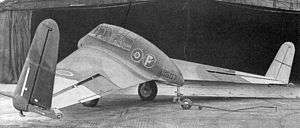General Aircraft GAL.56
| GAL.56 | ||
|---|---|---|
 | ||
| GAL.56/01 | ||
| Role | Experimental tailless gliders | |
| National origin | United Kingdom | |
| Manufacturer | General Aircraft Ltd | |
| First flight | November 1944 | |
| Number built | 4 | |
|
|} The General Aircraft GAL.56 was a family of 1940s British experimental tailless swept wing glider designs. BackgroundIn July 1943, the Tailless Aircraft Advisory Committee was set up under the Directorate of Scientific Research, within the Ministry of Aircraft Production. The purpose was to investigate the future possible use of tailless and tail-first concepts. In 1944, contract Acft/3303/CB.10(c) was issued to GAL for the construction and development of four unpowered proof-of-concept aircraft, three later designated as GAL.56, plus one GAL.61.[1] DesignThe three GAL.56 variants employed the same fuselage design, married to three different wing designs. The fuselage of the GAL.56 was constructed of steel tubes and wooden ribs, covered in moulded plywood sheeting. Accommodation was for pilot and observer, in tandem cockpits. For each variant, the wings were constructed of laminated wood spars and ribs, covered in wood/paper laminated skins. Each wing was attached to the fuselage by a joint via which the dihedral could be pre-set before flight. Elevons were provided to act as elevators for pitch control, and as servo-assisted ailerons for roll control. Two sets of split flaps were installed, of which either set could be selected before flight. A fin and rudder was mounted at each wingtip. The fixed main undercarriage struts, using existing components, were attached to the wing spars, and an extended tailwheel attached to the rear of the fuselage pod.[1][2] Variants
 GAL.61 Operational historyThe GAL.56/01 conducted numerous flights from RAF Dunholme Lodge and RAF Wittering, variously towed by a Whitley, Supermarine Spitfire, or a Handley Page Halifax. After May 1945, research flights continued at Farnborough, and in August 1947 it was transferred to the GAL Flight Test Department at Lasham Airfield, where the GAL.56/03 and GAL.56/04 were already employed for trials under contract to the Air Ministry. On 12 February 1948, the GAL.56/01 was conducting a stalling trial after being towed to 10,000 ft by a Halifax. The pilot, Robert Kronfeld, initiated a stall that progressed into an uncontrollable dive that caused both crew to lose consciousness. The observer, Barry MacGowan, awoke to find that the aircraft was level but inverted. He baled out successfully at low level, but Kronfeld died in the crash at Lower Froyle, near Lasham. As a result of the crash, and persistent stall problems on all tailless aircraft of the period, the research trials were terminated, the two other GAL.56s were transferred to the AFEE (Airborne Forces Experimental Establishment) at RAF Beaulieu, and the GAL.61 remained unflown.[1][5] Specifications (GAL.56/01)Data from Flight 26 September 1946 General characteristics
Performance
ReferencesCitations
6.http://www.flightglobal.com/pdfarchive/view/1948/1948%20-%200247.html?search=Robert Kronfeld Obituary for Kronfeld Bibliography
External links
| ||